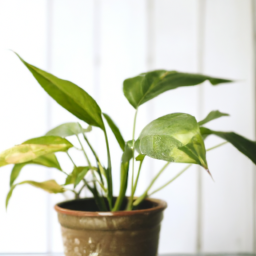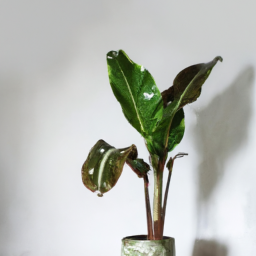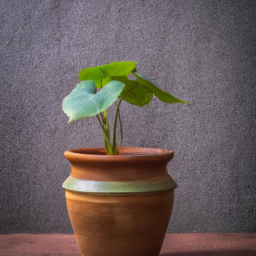
Are you looking to bring a touch of greenery into your home in India? Well, look no further! In this blog post, we will dive into the wonderful world of indoor plants in India. Whether you have a spacious apartment or a cozy little corner, indoor plants can add life, beauty, and a breath of fresh air to any space. Not only do they enhance the aesthetics of your home, but they also offer numerous health benefits. So, let’s explore the wide variety of indoor plants available in India and discover how to care for them to create a thriving indoor garden.
Benefits of Indoor Plants in India
Indoor plants not only add beauty to our homes and offices but also offer numerous benefits for our overall well-being. In India, where urbanization has led to limited green spaces, indoor plants have become a popular choice to bring nature indoors. Let’s explore the various advantages of having indoor plants in India.
1. Improved Air Quality
One of the significant benefits of indoor plants is their ability to purify the air we breathe. In India, where pollution is a major concern in many cities, indoor plants act as natural air purifiers. They absorb harmful pollutants such as formaldehyde, benzene, and xylene, which are commonly found in household items and cleaning products. Plants also release oxygen, making the air fresher and healthier to breathe.
Moreover, certain indoor plants like the Areca Palm, Snake Plant, and Peace Lily have been proven to remove toxins and improve indoor air quality by reducing the levels of carbon dioxide. Having these plants in your living spaces can help you combat air pollution and create a healthier environment.
Additionally, indoor plants can increase humidity levels, especially during dry seasons, which is beneficial for those suffering from respiratory problems like asthma or allergies. They act as natural humidifiers, providing relief and preventing respiratory discomfort.
2. Enhancing Mental Well-being
Indoor plants have a positive impact on our mental health and well-being. In India, where stress and anxiety are prevalent in urban settings, having indoor plants can help create a calming and soothing environment. The presence of greenery has been linked to reduced stress levels, improved mood, and increased productivity.
Studies have shown that being around plants can lower blood pressure and heart rate, promoting relaxation and reducing anxiety. The act of nurturing and taking care of indoor plants can also be therapeutic, allowing individuals to connect with nature and find solace in the process.
Furthermore, indoor plants can improve concentration and focus, making them ideal for offices and study areas. Their presence can boost creativity and provide a sense of tranquility, allowing individuals to work or study more effectively.
3. Health Benefits
Indoor plants offer various health benefits, making them a valuable addition to any living or working space in India. They have been found to reduce the risk of illnesses and improve overall well-being.
Firstly, indoor plants can help reduce fatigue and headaches by improving air quality and reducing the presence of harmful substances. They can also help alleviate symptoms of allergies and respiratory conditions, making them particularly beneficial for individuals with sensitivities.
Moreover, indoor plants have been shown to increase humidity levels, which can prevent dry skin and respiratory discomfort. They can also reduce the occurrence of dry coughs and sore throats, especially during the winter months when the air tends to be drier.
Additionally, indoor plants have a positive impact on sleep quality. Some plants release oxygen at night, promoting better sleep by improving air quality and creating a more peaceful environment.
In conclusion, indoor plants in India offer numerous benefits for our physical and mental well-being. They improve air quality, enhance mental health, and provide various health advantages. By incorporating indoor plants into our living and working spaces, we can create a healthier and more vibrant environment.

Popular Indoor Plants for Indian Homes
Indoor plants not only add a touch of greenery to our homes but also provide numerous benefits, such as improving air quality and reducing stress. With the variety of indoor plants available, it can be overwhelming to choose the right ones for your Indian home. In this article, we will explore some popular indoor plants that thrive in Indian conditions and are easy to care for.
1. Money Plant (Epipremnum aureum)
The Money Plant, also known as Devil’s Ivy, is a popular choice among Indian households due to its low maintenance and aesthetic appeal. It is believed to bring good luck and prosperity. This vine-like plant features heart-shaped leaves that grow rapidly, making it an excellent choice for hanging baskets or to be trained on a trellis.
To care for a Money Plant, place it in bright, indirect sunlight and water it moderately. The plant can tolerate low light conditions, but too much direct sunlight can scorch its leaves. Allow the soil to dry out between waterings, as overwatering can lead to root rot. Regularly wipe the leaves with a damp cloth to keep them clean and dust-free.
Money Plants are known for their air-purifying qualities, making them an ideal addition to any indoor space. They can remove toxins like formaldehyde and benzene from the air, creating a healthier environment for you and your family.
2. Snake Plant (Sansevieria trifasciata)
The Snake Plant, also known as Mother-in-law’s Tongue, is a hardy plant that can survive in various conditions, including low light and neglect. It has long, upright leaves with yellow or white variegation, adding a unique touch to any room.
This plant is an excellent choice for Indian homes as it can tolerate high temperatures and dry air. It is known for its ability to absorb toxins like formaldehyde, xylene, and toluene from the air, making it an excellent air purifier.
To care for a Snake Plant, place it in indirect sunlight or low light conditions. Water it sparingly, allowing the soil to dry out completely between waterings. Overwatering can cause root rot, so it’s crucial to avoid excessive watering. Snake Plants are also low maintenance when it comes to fertilization, requiring only occasional feeding with a balanced houseplant fertilizer.
3. Peace Lily (Spathiphyllum wallisii)
The Peace Lily is a beautiful flowering plant that adds elegance to any indoor space. It features glossy, dark green leaves and white flowers that resemble a white flag of peace. This plant is known for its ability to remove toxins like benzene, formaldehyde, and trichloroethylene from the air.
To care for a Peace Lily, place it in bright, indirect sunlight. Although it can tolerate low light conditions, it may not bloom as profusely. Keep the soil consistently moist but avoid overwatering, as it can lead to root rot. The plant will droop when it needs water, but it quickly recovers after watering. Mist the leaves occasionally to increase humidity, especially during dry seasons.
Peace Lilies are relatively low maintenance and can thrive in Indian homes with proper care. However, it’s important to note that they are toxic to pets, so it’s best to keep them out of reach of curious animals.
By incorporating these popular indoor plants into your Indian home, you can enhance the aesthetics, improve air quality, and create a calming environment. Remember to provide each plant with the care it requires, and enjoy the benefits they bring to your indoor space.

Tips for Caring for Indoor Plants in India
Understanding the Indian Climate
When it comes to caring for indoor plants in India, it is important to consider the unique climate of the country. India experiences a tropical monsoon climate, characterized by high temperatures, humidity, and heavy rainfall. These conditions can greatly affect the health and growth of indoor plants.
One of the key factors to keep in mind is the temperature inside your home. Most indoor plants thrive in temperatures between 60°F (15°C) and 75°F (24°C). However, in India, the average temperature can be much higher, especially during the summer months. It is important to choose indoor plants that can tolerate higher temperatures and provide them with proper ventilation and air circulation.
Humidity is another crucial aspect to consider. India has high levels of humidity throughout the year, which can lead to fungal diseases and other issues for indoor plants. To combat this, you can use a dehumidifier or place a tray of water near your plants to increase humidity levels. Additionally, avoid overwatering your plants, as excessive moisture can promote the growth of mold and mildew.
Choosing the Right Indoor Plants
When selecting indoor plants for your home in India, it is important to choose varieties that can thrive in the local climate. Here are a few popular options:
1. Money Plant (Epipremnum aureum): This is a popular choice for indoor gardening in India due to its ability to tolerate a wide range of temperatures and humidity levels. Money plants also have air-purifying properties, making them a great addition to any home.
2. Snake Plant (Sansevieria trifasciata): Snake plants are known for their ability to survive in low light conditions and can tolerate high temperatures. They also have air-purifying qualities and can help improve indoor air quality.
3. Spider Plant (Chlorophytum comosum): Spider plants are easy to care for and can adapt well to the Indian climate. They prefer bright, indirect light and can tolerate a wide range of temperatures.
Caring for Your Indoor Plants
Proper care and maintenance are essential for the health and longevity of indoor plants in India. Here are some tips to ensure your plants thrive:
1. Lighting: Most indoor plants require bright, indirect light. Place your plants near windows or in well-lit areas of your home. However, avoid exposing them to direct sunlight, especially during the peak afternoon hours when the sun is the strongest.
2. Watering: The watering needs of indoor plants can vary, so it is important to understand the specific requirements of each plant. In general, it is better to underwater than overwater. Check the moisture level of the soil regularly and water only when the top inch feels dry. Avoid waterlogging, as it can lead to root rot and other issues.
3. Fertilizing: Indoor plants in India may benefit from regular fertilization, especially during the growing season. Use a balanced, water-soluble fertilizer and follow the instructions on the package. Be careful not to over-fertilize, as it can cause nutrient burn and damage the plant.
4. Pruning and Cleaning: Regular pruning helps promote healthy growth and prevents the plant from becoming too leggy or overcrowded. Remove any dead or yellowing leaves and trim back overgrown branches. Additionally, dust the leaves of your indoor plants regularly to keep them clean and free from pests.
5. Pest Control: Indoor plants are susceptible to pests such as spider mites, mealybugs, and aphids. Inspect your plants regularly for any signs of infestation, such as webbing, sticky residue, or wilting leaves. If you notice pests, treat them immediately with organic insecticides or natural remedies like neem oil or soapy water.
By following these tips and providing the right care, you can enjoy a thriving indoor garden in India. Remember to observe your plants closely and make adjustments as needed to ensure their well-being. Happy gardening!
Here’s the Summary Snapshot
Indoor plants have become increasingly popular in India, and for good reason. Not only do they add a touch of greenery and beauty to our homes, but they also offer numerous health benefits. With the rise in pollution levels and urban living, indoor plants have become a necessity for many households.
One of the main advantages of indoor plants is their ability to purify the air. They absorb harmful toxins and release oxygen, creating a healthier and fresher environment. In a country like India, where air pollution is a major concern, having indoor plants can significantly improve the quality of the air we breathe. Additionally, studies have shown that indoor plants can reduce stress levels and improve mental well-being. Their presence can create a calming and soothing atmosphere, making our homes a sanctuary from the hustle and bustle of everyday life. Whether it’s a small succulent on a windowsill or a larger potted plant in the living room, incorporating indoor plants into our homes is a simple and effective way to enhance our overall well-being.
Top FAQs:
Q1: What are the best indoor plants to grow in India?
A1: There are several indoor plants that thrive in the Indian climate. Some popular choices include the Snake Plant, Peace Lily, Money Plant, Areca Palm, and Spider Plant. These plants are known for their ability to adapt to different light conditions and require minimal maintenance.
Q2: How do I care for indoor plants in India?
A2: Caring for indoor plants in India involves providing them with the right amount of water, sunlight, and nutrients. Most indoor plants prefer indirect sunlight, so placing them near a window or in a well-lit room is ideal. It’s important to water them regularly, but avoid overwatering as it can lead to root rot. Additionally, using well-draining soil and fertilizing them occasionally will help keep your indoor plants healthy.
Q3: Can indoor plants survive in air-conditioned environments?
A3: Yes, many indoor plants can survive in air-conditioned environments. However, it’s important to note that air-conditioning can dry out the air, which may affect the humidity levels that some plants require. To counter this, you can mist your plants occasionally or place a tray of water near them to increase humidity. Additionally, avoid placing plants directly in front of air vents to prevent temperature extremes.
Q4: Are there any indoor plants that can purify the air in India?
A4: Yes, certain indoor plants are known for their air-purifying properties. Plants like the Snake Plant, Peace Lily, and Areca Palm are excellent choices for improving indoor air quality. They help remove toxins and pollutants from the air, making your living space healthier. However, it’s important to note that while these plants can contribute to cleaner air, they may not eliminate all pollutants.
Q5: Where can I buy indoor plants in India?
A5: Indoor plants can be purchased from various sources in India. You can visit local nurseries, garden centers, or plant shops in your area. Additionally, many online platforms and e-commerce websites offer a wide range of indoor plants that can be delivered to your doorstep. Make sure to choose a reputable seller and consider factors such as plant quality, shipping options, and customer reviews when making your purchase.
Dr. Olivia Green is a botanist with over two decades of experience in indoor plant cultivation. She holds a Ph.D. in Plant Biology and has dedicated her career to researching plant behavior in controlled environments. Dr. Green is passionate about helping plant enthusiasts master the art of indoor gardening through her extensive knowledge and practical insights.


